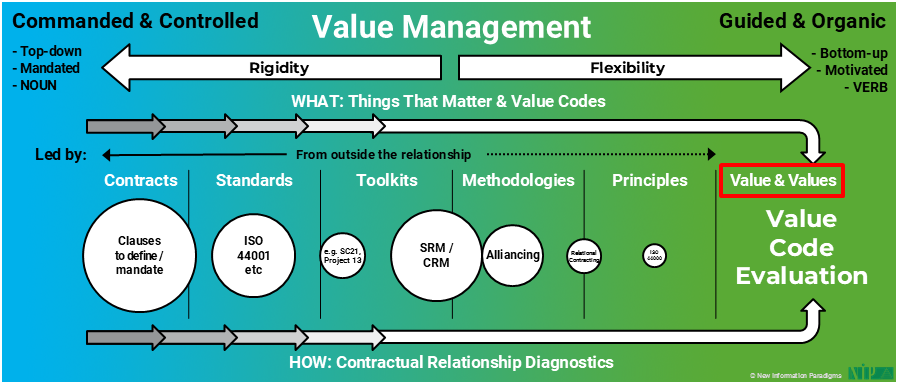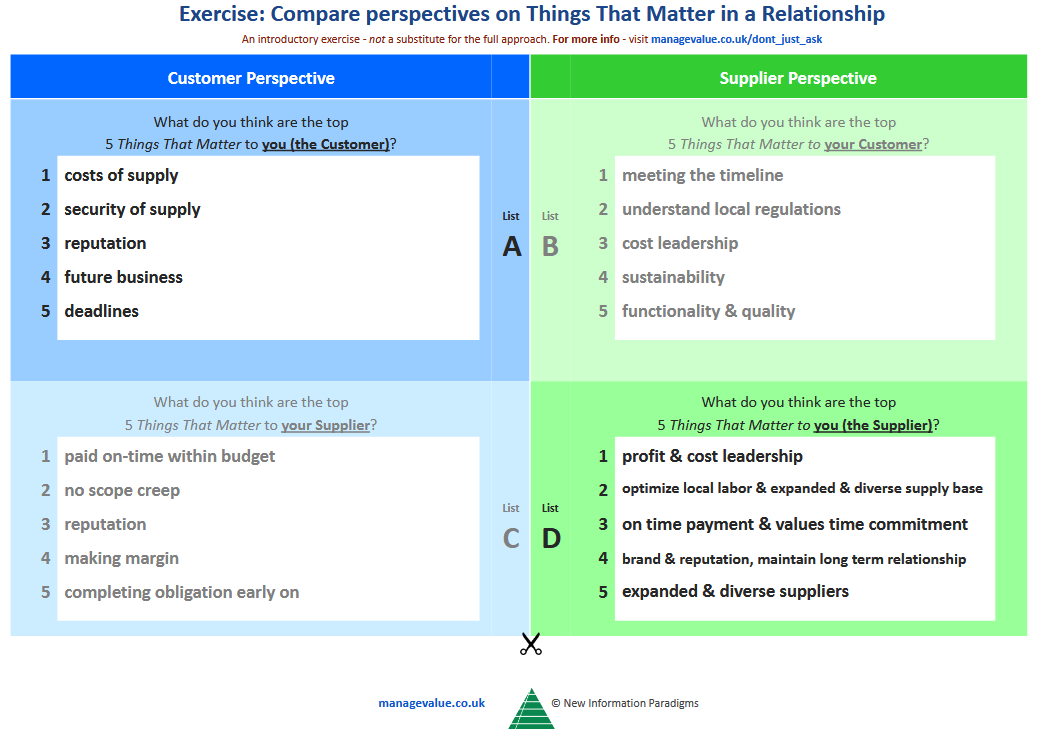Enhancing Contract Management
There is an increasing awareness that contracts – at least as currently used – are not fit for purpose, and that they often work against the quality and effectiveness of the relationship:
- They can’t anticipate or respond quickly to unexpected developments, creating gaps and a rush to try and renegotiate or redefine terms.
- They usually aren’t readily understandable, applicable and usable at the front line – especially where quick decisions are needed.
- Most of all, they can’t capture the crucial subjective Things That Matter.
Whilst contracts will remain an indispensable tool, providing crucial legal and operational detail, something else is needed to help contract and relationship management keep pace.
Our default Contractual Relationship Diagnostic provides a powerful first step here.
It illustrates – and provides a starting point for – how Value Management can be used to reach a mutually-agreed complement to the contract that focuses on the (primarily subjective) Things That Matter that the contract doesn’t/can’t cover.
It’s illustrative in that its contents aggregate learning from across relationships, rather than being specific to any one relationship; it’s a starting point, because it can be adapted over time in any given relationship.
Otherwise, the way that Value Management is applied in contractual relationships is:
- The Three Step Process is used to clarify, personalise and agree the Things That Matter between the parties, expressing strategic value in a shared language: a completely new approach to encapsulating the relationship.
- As well as then keeping these “alongside” the contract, the agreed Things That Matter can be published and circulated so that everyone knows what is valuable and so that actions taken are consistent with what has been agreed to matter.
- This could be global – everything shown to everyone – and/or targeted subsets of Things That Matter highlighted to specific groups.
- The Things That Matter are then reworked into Value Codes, such that agreed priorities are expressed as to how they look in practice and can be added to the contract complement.
Finally, the Value Codes are assembled into a diagnostic: a completely new way of managing the relationship, where – alongside existing contract management activities – the parties evaluate and agree current performance levels, set targets and take action in key areas where this was previously not possible.
At scale, the Value Codes are evaluated by all involved, with the option for them to propose improvement actions; divergence is discussed and resolved; a current state and a desired state are agreed for each Value Code.
As things improve, the contract complement can be updated – a dynamic expression and management of the relationship in a way that a traditional contract never can be.

Featured content:
- The Contractual Relationship Diagnostic and how it helps widen the focus of contract management
- How the Three Steps to Value can Transform Contracting
Our Contract Complement System:
Articles related to Contract Management:
The Transformation Needed for CCM: Part 2
Value is talked about everywhere, but it’s misunderstood. And this really matters because value is central to everything. Unfortunately, value isn’t properly in focus….
The Transformation Needed for CCM: Part 1
Value Management is what’s needed to truly transform the CCM role. But why is transformation needed? Because there are existential threats to the CCM role….
Negotiating Value in Contractual Relationships: Part 3
With a broader conception of “negotiation” in mind, we can now fill in the missing piece of our relationship management spectrum with Value Management: Things That Matter, Value Codes and Diagnostics….
Negotiating Value in Contractual Relationships: Part 2
Warranties, intellectual property rights, liquidated damages, and so on, are important. But it’s things like values, perceptions, effectiveness of communication, and behaviours that primarily affect contract delivery, and that determine the quality of the relationship. How do we “negotiate” those?…
Negotiating Value in Contractual Relationships: Part 1
Value is why we do anything: it’s the goal of our relationships, it’s what our contracts should support, and it’s what the negotiations for those contracts should focus on. But “value” is a much-misunderstood term……
Value Management: How to Avoid Being Overwhelmed
If they don’t realize it already, they will soon: anyone engaged in relationships is becoming overwhelmed by the difficulties and Complexity of decisions and trade-offs. Experience-based intuition currently bridges the gap, but it can’t scale and is doomed to fail. Here, we see the ideal…
Empathy: the Missing Piece of the Collaboration Puzzle
Commercial relationships are struggling, and nowhere is this more true than in collaborative relationships. Such relationships are where Complexity – from both inside and outside the relationship – is highest, and where the fatal flaws in how we typically operate are most clearly (and devastatingly)…
Misalignment on Things That Matter: Proving the Point
The Things That Matter aren’t clear or aligned in our relationships. This missing empathy is what is inhibiting understanding, preventing the management of differences, and hampering authentic collaboration. All of this – and more – was demonstrated through a recent workshop exercise we ran….
Request an invitation
Request an invitation to self-diagnose the symptoms of what’s not working in your strategic relationship by sending us the following information.








